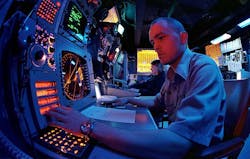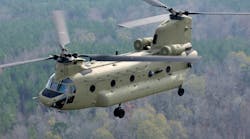Officials of the Office of Naval Research (ONR) in Arlington, Va., have released a broad agency announcement (ONRBAA14-006) for the Electronic Warfare Technology program, which seeks to develop and demonstrate technologies for the next generation of systems in EW.
The goal is to enable Navy and Marine Corps forces to control the electromagnetic spectrum by exploiting, deceiving, or denying enemy use of the spectrum while ensuring its use by friendly forces.
Related: Electronic warfare: the cat-and-mouse game continues
Topics of interest include improved threat warning systems; electronic warfare support (ES); decoys and countermeasures against weapon tracking and guidance systems; electronic attack (EA) against adversary command, control, communications, computers, intelligence, surveillance, and reconnaissance (C4ISR); and electronic protection (EP) of our own weapons and C4ISR from intentional and unintentional interference.
The four areas of core interest are radio frequency and millimeter wave electronic warfare subsystem demonstrators; compact and efficient EW antennas covering frequencies ranging from 3 to 300 MHz; W-band millimeter wave high-power transmitters; and innovative EW concepts.
RF and millimeter wave EW subsystem demonstrations should use either existing open-systems standards such as OpenVPX, or industry standards to which the government has full and open rights, Navy researchers say. Reducing size, weight, and power (SWaP) is a driving concern.
Related: Electronic warfare is where it's at today in aerospace and defense
Compact and efficient EW antennas covering frequencies ranging from 3 to 300 MHz seeks to enable Navy, Marine Corps, and joint-service EW systems to detect, deny, or deceive sensors, communications or other systems operating in the HF and VHF bands. Goals include developing small antennas no longer than one meter with directional capabilities.
W-band millimeter wave high-power transmitters will involve frequencies from 75 to 110 GHz able to achieve one to four kilowatts for small decoy applications, or that can be combined to achieve 100 kilowatts or more for large platforms.
Innovative EW concepts seeks to explore concepts that fundamentally could change the way military forces conduct EW operations.
Related: Programmable radar and adaptive electronic warfare take center stage
ONR officials will brief industry on the Electronic Warfare Technology program this Friday, 10 Jan. 2014, in Arlington, Va. Register by email no later than Tuesday 7 Jan. 2013 to [email protected]. Those registering will be emailed the location of the briefings. Briefing slides and answers to questions will be available online after 14 Jan. 2013 at www.onr.navy.mil/02/BAA.
Companies interested in bidding on the Electronic warfare Technology program should submit white papers no later than 4 Feb. 2014, and full proposals no later than 6 May 2014.
Email technical questions or concerns to the Navy's Peter Craig at [email protected] or Kevin Rudd at [email protected]. Email business questions to Alan Kesten at [email protected].
More information is online at https://www.fbo.gov/spg/DON/ONR/ONR/ONRBAA14-006/listing.html.



